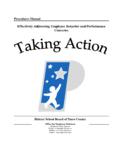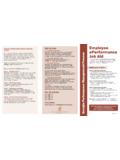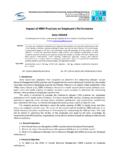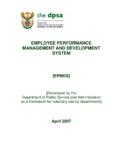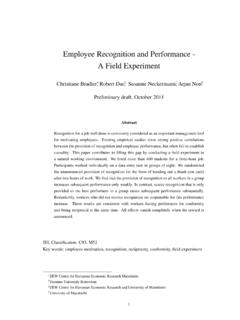Transcription of Effectively Addressing Employee Behavior and Performance ...
1 Procedures Manual Effectively Addressing Employee Behavior and Performance Concerns District School Board of Pasco County Office for Employee Relations Elizabeth P. Kuhn, Director Thomas A. Neesham, Supervisor Kathleen A. Scalise, Supervisor Sandra J. May, Equity Manager 2 Office for Employee Relations 2014 Table of Contents Taking Action Introduction ..3 Defining the Problem - Walking Through the Steps ..4 Step 1 Determine if the concern should be addressed with the Employee Step 2 Select and execute data gathering activities Step 3 Classify the problem(s) Step 4 Review information and formulate a written statement of the problem(s) Step 5 Select the appropriate corrective process Step 6 Select appropriate corrective action based on progressive discipline Progressive Discipline Model ..6 Utilizing Effective Progressive Discipline ..7 Calling a Meeting with an Employee ..8 Child Protective Investigations and Law Enforcement.
2 9 Addressing Performance Deficiencies The NEAT Process 1. Notice .. 10 2. Explanation .. 11 3. Assistance .. 12 4. Time .. 12 5. Signature Block .. 13 Common Mistakes with NEAT Letters .. 14 Addressing Behavioral Concerns The Letter of Reprimand .. 15 Essential Components of a Reprimand .. 16 Common Mistakes with Reprimands .. 17 Attendance Monitoring Problems with Attendance .. 18 How to Address an Attendance Problem .. 19 Templates for Any Category of Employee Sample Letter - Employee Conference 22 Sample Letter - Attendance .. 23 Sample Letter - Letter of Caution - Behavior Concern .. 24 Sample Letter - Formal Letter of Reprimand - Behavior Concern .. 25 Sample Letter - Job Abandonment ..26 Instructional Employees Probationary Teacher Concerns .. 28 Annual Contract Teacher Concerns .. 28 Professional Services Contract or Continuing Contract Teacher Concerns .. 28 Sample Letter Probationary or Annual First Notice.
3 30 Sample Letter Probationary or Annual Contract Teacher Letter if Concerns Persist .. 31 Sample Letter Informal NEAT Letter Performance Concern .. 32 Sample Letter Formal NEAT Letter Performance Concern .. 33 Noninstructional Employees Sample Letter Probationary SRP or NNB .. 36 Sample Letter Non-Probationary SRP or NNB Informal NEAT Letter Performance Concern .. 37 Sample Letter Non-Probationary SRP or NNB Formal NEAT Letter Unsatisfactory Evaluation .. 38 3 Office for Employee Relations 2014 Introduction Taking Action Effective schools have effective administrators who readily recognize effective and ineffective teaching and educational support practices and Behavior . It is expected that all employees function at a high level of Performance and Behavior ; however, there may be times when the Performance or professional Behavior of an Employee reduces his/her effectiveness in the classroom, school, worksite, and/or community.
4 It is imperative that an administrator has a skilled professional who is committed to providing quality education for each student in every position instructional or noninstructional. Therefore, it is important that the administrator take corrective action when behavioral or Performance deficiencies arise. It is equally important that the action be appropriate to the situation. If possible, the action should focus on continuous professional growth by providing guidance, support, supervision, and resources. The purpose of this manual is to provide administrators with assistance in making timely decisions and prescribing the appropriate action to be taken. Due to some of the inherent differences between instructional and noninstructional staff, this manual has been divided into sections for templates and information appropriate for all categories of employees, instructional employees, and other non-instructional staff, including School Related Personnel (SRP) and Noninstructional Nonbargaining Employees (NNB).
5 4 Office for Employee Relations 2014 Defining the Problem Walking through the Steps Step 1: Determine if the concern should be addressed with the Employee . In most cases the report or existence of a concern will create the need for some type of investigation and ultimately a discussion with the Employee . There are some cases, however, where the concern will be so small and/or isolated that a simple notation of the concern, paired with a future monitoring plan, will suffice. Example: A teacher who has been on time to work, every day for 12 years, is five minutes late to school on a given day. As long as the tardiness is not habitual, and there is nothing to indicate that the tardiness is a symptom of a larger problem, simply keeping note of the occurrence (see Action Log - ) and monitoring arrival time should be sufficient. However, if the tardiness is more frequent, or the teacher is 15-20 minutes late, additional action may be required.
6 Use your best professional judgment in answering this question. If you are unsure, call Employee Relations for assistance. Step 2: Select and execute data gathering activities. The type of concern that you are dealing with will often dictate the types of data gathering techniques most appropriate in Addressing the concern. Example: If you have concerns with a teacher s effectiveness in the classroom, a combination of classroom observations, student assessment data review, and lesson plan evaluation will probably be most helpful. However, if you are dealing with a teacher who has been accused of inappropriate language with a student, the staff member and student interview will probably prove most helpful. Regardless of your data collection method, you should document it. Step 3: Classify the problem(s). Identify the general category of problem that you are encountering. These categories include: Work Habits (Missing paperwork deadlines or consistently arriving late to work.)
7 Personal Behavior At Work (Gossiping about others, or being uncooperative.) Classroom Performance (Students off-task or a high number of students performing unsatisfactorily.) Personal Behavior Away From School (Discussing confidential student information within the community.) Outside Agency Referral (Child abuse allegation, or arrest by law enforcement.) It is quite possible that a concern might fall into more than one of these categories, or that you will be dealing with multiple concerns that fall into a variety of categories. Step 4 Review information and formulate a written statement of the problem(s). Use the data you have collected to develop an effective statement of the problem. Summarize the information that supports your conclusions. Ensure that the statement is clear, precise, and unambiguous. Your statement should stick to the facts you have collected as much as possible and should provide a detailed explanation of what the problem is and why it is a problem.
8 5 Office for Employee Relations 2014 Examples: Incomplete Problem Statement: The teacher does not maintain a classroom environment conducive to effective learning. Add Detail to Complete the Statement: Students interfere with the teacher s instructional presentation by speaking out during the lesson. Students get out of their seats without permission and wander around the classroom during classroom activities. During a fifteen (15) minute observation, five (5) students spoke out during the lesson without being redirected and four (4) students were wandering around the classroom without the teacher noticing or Addressing . Step 5 Select the appropriate corrective process. Now that the problem has been defined, the administrator must now determine what action to take. There are two general categories of corrective action, the Performance process and the behavioral/reprimand process. Performance Problem A concern that is best addressed through the District s Performance evaluation process.
9 Behavioral Problem Usually a single incident that occurs requiring some form of immediate administrative action. Inappropriate interactions with others, verbal outbursts, and other judgment-related issues highlight Behavior problems. The corrective action processes for Performance and Behavior are not always exclusive of one another. In many cases they interact with one another and multiple corrective actions may need to be taken to address a single concern or incident. Step 6 Select appropriate corrective action based on progressive discipline. The final step involves analyzing the problem or concern and deciding what is the least severe, yet still appropriate, action that should be taken. Making this decision involves looking at not only the severity of the immediate problem or concern, but also looking at whether or not the Employee has had difficulties in this same area in the past.
10 Progressive discipline does not require that you always start with the least severe consequence, or that you follow every step on the progressive discipline continuum, and there is no guarantee that progressive discipline will be appropriate in every situation. The administrator should evaluate all the facts and context involved to make an informed decision. Employee Relations can provide guidance in this area if needed. 6 Office for Employee Relations 2014 Progressive Discipline Model Informal Letter (Informal NEAT Letter or Informal Letter of Reprimand/Letter of Caution) Verbal Warning Termination of Employment Unsatisfactory Evaluation or Suspension Without Pay Formal Letter (NEAT Letter or Formal Reprimand) Conference Summary 7 Office for Employee Relations 2014 Utilizing Effective Progressive Discipline Plan the Discussion.
